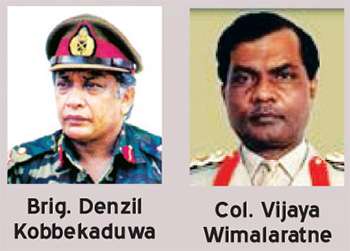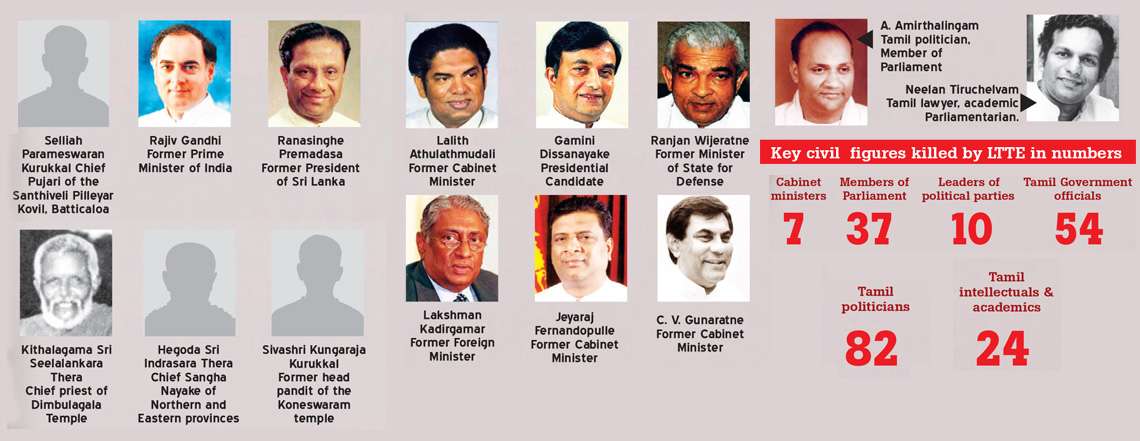18 May 2018 - {{hitsCtrl.values.hits}}

The Liberation Tigers of Tamil Eelam (LTTE) was a terrorist organization formaly based in northern Sri Lanka. Founded in May 1976 by Vellupillai Prabhakaran, it waged a violent secessionist campaign to create an independent state in the north and east of Sri Lanka. This evolved into a full scale terrorist campaign until 2009, when the LTTE was defeated by the Sri Lankan Military.
FIRST VICTIM
Prabhakaran began his career by murdering Alfred Duraiappah in 1975, the then mayor of Jaffna.
FIRST MAJOR ATTACK
LTTE killed 13 soldiers in Jaffna on July 23, 1983. The attack and subsequent riots in the south (dubbed Black July) are generally considered as the beginning of the conflict.
FIRST CIVILIAN ATTACK
Nov 3, 1984: LTTE killed 67 civilians including women & children in Dollar & Kent Farms in Weli Oya.

 FIRST FULL SCALE OPERATION AGAINST LTTE IN 1987
FIRST FULL SCALE OPERATION AGAINST LTTE IN 1987
Operation Liberation or the Vadamarachchi Operation was the military offensive carried out by the Sri Lankan military in May and June 1987 to recapture the territory of Vadamarachchi in the Jaffna peninsula from the LTTE. It was the first conventional warfare engagement on Sri Lankan soil after the end of British colonial rule.
The offensive started on May 26, 1987, under the leadership of two commanders Brig. Denzil Kobbekaduwa and Col. Vijaya Wimalaratne with 8,000 troops from several battalions. The offensive was successful, and the LTTE leader Prabhakaran and the Sea Tiger leader Soosai narrowly escaped from advancing troops at Velvettithurai.
The Vadamarachchi Operation had cornered the LTTE in Jaffna and were confident of bringing an end to the conflict. The second stage of this operation was launched on June 3, 1987, with the goal of capturing the city of Jaffna, but was abandoned due to Indian pressure. Indian military cargo planes escorted by fighter aircraft dropped humanitarian relief supplies in the Jaffna area on June 4 in Operation Poomalai. Indian forces landed in Sri Lanka on July 29 with the signing of the Indo-lanka accord.
ATTACKS ON RELIGIOUS PLACES
LTTE attacked sacred city of Anuradhapura on 14 May 1985 killing 120 devotees including children and wounding scores of others. LTTE attacked a mosque in Kattankudy on 4 August 1990 & massacred 103 Muslims injured over 70 while they were at prayers. January 25, 1998 LTTE sends a suicide mission to attack Sri Lanka's holiest Buddhist shrine the Temple of the Tooth in Kandy killing 13 and damaging the historic site.
ETHNIC CLEANSING
The LTTE has been blamed for forcibly removing Sinhalese and Muslim inhabitants from areas under its control, including the use of violence against those who refuse to leave. Most notably, the LTTE forcibly expelled the entire Muslim population of Jaffna with two hours notice in 1990.
SUICIDE ATTACKS
In July 5, 1987, the LTTE carried out their first suicide attack. "Captain Miller" of the Black Tigers drove a small truck carrying explosives through the wall of a fortified army camp, reportedly killing forty soldiers. From their formation in 1987 until the defeat of the LTTE in 2009, more than 330 Black Tigers made suicide attacks on land and sea. In July 2001, 14 Black Tigers attacked Bandaranaike International Airport, causing an estimated USD 350 million worth of damage, mainly to military and civilian aircraft.
NOTABLE PEOPLE KILLED BY THE LTTE
LTTE is the only terrorist group to have killed 2 international political leaders. One on foreign soil - Rajiv Gandhi, former PM of India & Sri Lanka's President R Premadasa on May Day. LTTE has also made a bid to assassinate President Kumaratunga who escaped but lost her eye sight as a result of the shrapnel.

PEACE ATTEMPTS MADE BY THE GOVERNMENT
Several attempts were made to find a peaceful solution to the conflict with help of foreign countries since 1985. The Government had 5 peace talks (1985, 1990, 1995, 2002 and 2006 with ceasefires and all ended with LTTE regrouping and attacking the civilians and military forces.
Sri Lanka is the first country in recent times in the world to eradicate terrorism on its own soil
For over 25 years, LTTE terrorism caused significant hardship to the population, environment and the economy of the country, with an estimated 80,000 –100,000 people killed during its course. After two decades of fighting and four failed tries of peace talks, including the unsuccessful deployment of the Indian Army, the Indian Peace Keeping Force from 1987 to 1990, the Sri Lankan military forces defeated the LTTE in May 2009, bringing the terrorist war to an end.
EAST OPERATION
In the Eastern Theatre of Eelam War IV, the warfare started in the Eastern Province of Sri Lanka on July 21, 2006, when the LTTE cut off the water supply to the paddy fields in the Mavilaru area in the Trincomalee district.
NORTH OPERATION
In 2007, the government forces shifted their offensive to the north of the country, and formally announced their withdrawal from the ceasefire agreement (CFA) on January 2, 2008, charging that the LTTE violated the agreement over 9,000 times.
NANTHIKADAL BATTLE
The 58 , 59 and 53 Divisions of the Army , after having boxed the remaining LTTE cadres into a small area of territory near Nandhikkadal lagoon, linked up and eliminated the remaining cadres. This final battle claimed the lives of several top LTTE leaders, including Jeyam, Bhanu, Lawrence, Pappa, Laxamanan, Nadesan, Pottu Amman, Soosai and Velupillai Prabhakaran who attempted to flee as reported.

23 Dec 2024 10 minute ago
23 Dec 2024 19 minute ago
23 Dec 2024 19 minute ago
23 Dec 2024 2 hours ago
23 Dec 2024 3 hours ago